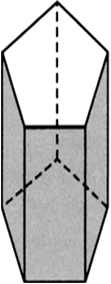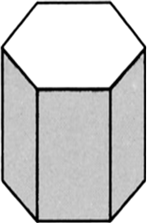Here:
Number of vertices (V) = 20
Number of edges (E) = 30
Let the number of faces are F. Then using Euler's formula, we have
F + V = E + 2 ...(1)
∴ Substituting the values of V and E in (1), we get
F + 20 = 30 + 2![]() F + 20 = 32
F + 20 = 32![]() F = 32 - 20
F = 32 - 20![]() F = 12
F = 12
Thus, the required number of faces = 12.
Number of vertices (V) = 8
Number of edges (E) = 12
Let the number of faces = V
Now, using the Euler's formula
F + V = E + 2
we have
F + 8 = 12 + 2![]() F + 8 = 14
F + 8 = 14![]() F = 14 - 8
F = 14 - 8 ![]() F = 6
F = 6
Thus, the required number of faces = 6.
If a polyhedron is having number of faces as F, number of edges as E and the number of vertices as V, then the relationship F + V = E + 2 is known as Euler’s formula. Following figure is a solid pentagonal prism.
It has:
Number of faces (F) = 7
Number of edges (E) = 15
Number of vertices (V) = 10
Substituting the values of F, E and V in the relation,
F + V = E + 2
we have
7 + 10 = 15 + 2![]() 17 = 17
17 = 17
Which is true, the Euler’s formula is verified.

∵ The ends (bases) of the given solid are congruent rectilinear figure each of six sides.
∴ It is a hexagonal prism.
In a hexagonal prism, we have:
The number of faces = 8
The number of edges = 18
The number of vertices = 12
